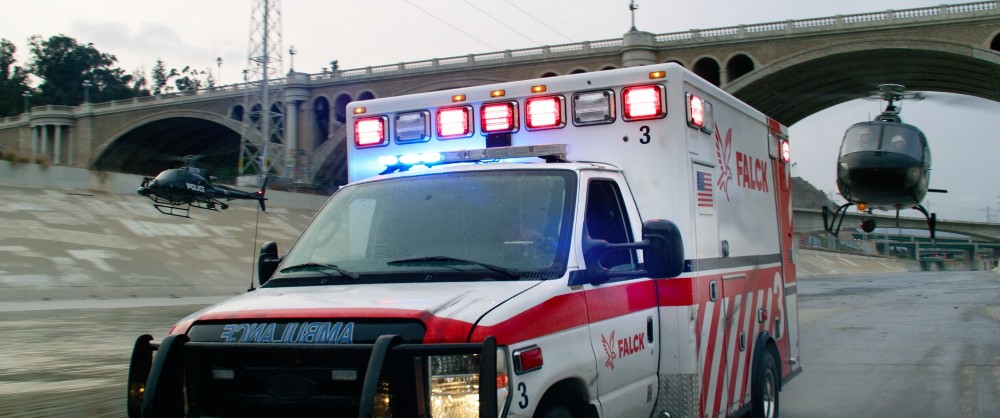
Michael Bay’s Ambulance may not have made much noise at the box office when it was released a few months back, but one of the reasons it’s such an exciting action movie is the innovative way that it was shot. Much of the success of those action sequences comes down to the use of high-speed FPV racing drones with cameras attached to them.
The team behind those drones included the film’s Drone Coordinator, Davis DiLillo, and drone pilots Alex Vanover and Jordan Temkin, all of whom came to the project via Lightcraft, the Los Angeles production services company that not only provides aerial drone photography and equipment but also underwater services and much more. The three of them were part of the film’s Aerial Department, which included a separate aerial cinematography team (led by Aerial DP David Nowell) and several helicopter pilots.
Ambulance stars Yahya Abdul-Mateen II and Jake Gyllenhaal as half-brothers who stage an elaborate heist and end up escaping by hijacking an ambulance containing a police officer they shot. They’re chased throughout downtown L.A. by a number of police vehicles, all captured by Lightcraft’s high-speed drone cameras that could even zoom through the parking garage at the Staples Center.
Below the Line spoke to the three men for the following interview. Enjoy!
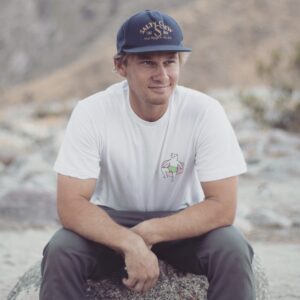
Below the Line: Let’s just start with some background, if that’s okay. I don’t know a lot about drone filmmaking, but I know it’s become fairly common and cheaper than renting helicopters. What was your background before getting into Lightcraft, and how long has that been going?
Davis DiLillo: I had been flying drones for 10 years, mostly for cinema purposes. I started out doing action, sports, and commercials, and slowly worked my way up in the ranks and started getting on more major motion pictures. Basically, about two years ago, I started flying cinema cameras — specifically, the Red Gemini on an FPV drone — and I was like, ‘Wow, this is definitely the future for action, cinematography.’ And then, I started trying to find the right talent. Jordan and Alex are some of the best pilots in the world, so instead of trying to learn and fly these things myself, I went out and grabbed the two best drone racing league pilots in the world. They had been flying drones almost as long as me, though in a completely different way.
Drone Racing versus traditional drones, just so that you can have an understanding of the differences, traditional drones have a flight controller with a computer, and you basically are moving the drone around in the sky like a video game. Whereas these racing drones, they basically are humans flying them, like a fighter pilot. It’s a completely different style. It requires a lot more skill, and these guys are the best in the world. Just starting off, we had a huge advantage with our technology and our pilots. Michael Bay found us, and Ambulance was an incredible film to work on. Never had an opportunity to shut down four or five blocks of L.A. with machine guns going off, an absolutely incredible experience.
BTL: I speak to many cinematographers and some camera operators. Do you prefer being referred to as drone pilots vs. camera operators? Is there a major difference?
Jordan Temkin: I like to always joke that I’m a dolly operator in the air. It actually depends on the drone that we’re flying. If we’re flying FPVs like we were in Ambulance, then the camera is base-mounted onto the drone, so any movement that we do as a pilot is also going to move the camera because it’s one-to-one. In that case, we are acting as a drone pilot and a camera operator because we’re the ones in charge of framing. When we fly a more traditional drone with a gimbal and we have a second operator who’s controlling the camera, then I would consider myself the drone pilot, and then the operator would be the one operating the gimbal. In the case of Ambulance, we were both drone pilot and operator.
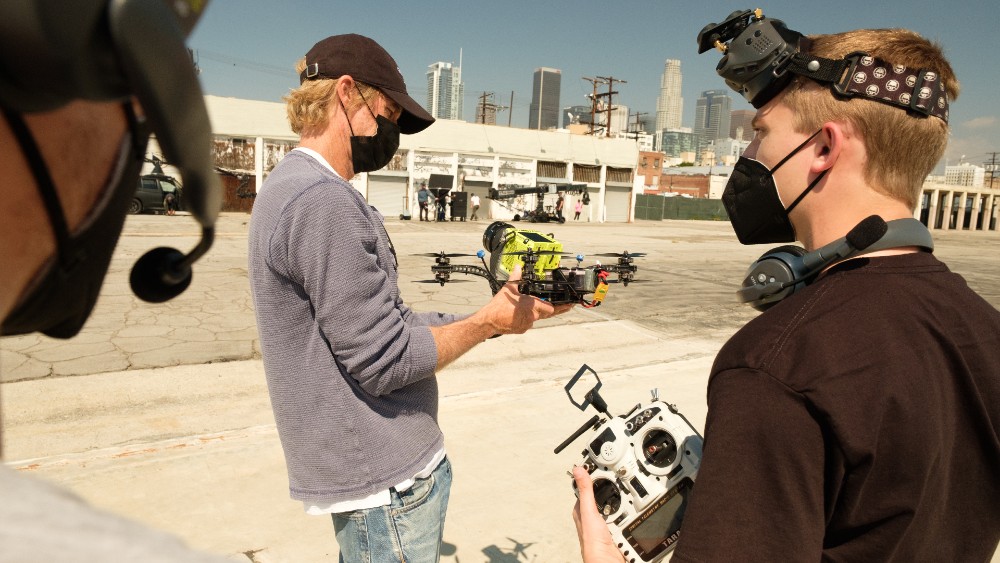
BTL: How were you approached by Michael Bay? Had he seen some of your work, or had you worked on something else with him before? What was the connection?
DiLillo: Right when we started demonstrating this content, it started to get viral. We have a shot [where] we were diving down the Air Korea building in downtown LA. It’s a glass building, and it was unique because we were looking at the glass, and it was reflecting Santa Monica and the coastline, and we’re 10 feet off the glass. So it was a very unique shot, and then we had an epically crazy dive into Grand Avenue. There’s like a hole in the ground in between skyscrapers, and we have a motorcycle that was ripping underneath it, and we timed it perfectly so that went from the top of this building to the motorcycle, straight down. Michael saw these shots, and he was immediately like, ‘This looks like VFX. We need this for our film.’ And [Producer] Michael Kase reached out, [and] we had an incredibly intense conversation. At the end of it, he decided to go with us, so we were stoked.
BTL: Did you go on location scouts with the main DP to figure things out? I’m guessing you guys are all in L.A. and know downtown at least a little bit, but how do you plan for something like this?
DiLillo: Yeah, there were about seven days of location scouts. A lot of it was coordinating permitting with the locations department, who was fantastic on this film. I’ve never seen as big of a lock-off in Los Angeles, as Michael Bay got for Ambulance. It was like four square blocks, no pedestrian traffic; the city was ours, and they’re shooting 5,000 rounds of blanks off, and it sounds like a warzone. We basically had full reign of all the locations around us. Not often does that happen, if at all nowadays.
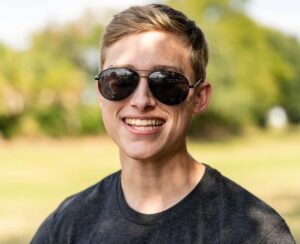
BTL: Is there any storyboarding involved in what you’re doing? Jordan and Alex, how are you guys planning and figuring out how to shoot what was going on?
Alex Vanover: I would say that we just got a lot of directives verbally from Bay. He would tell us, ‘I want you to come off that building. I’m going to have a guy at the bottom shooting. I just want you to look straight down on him, and track the building as you’re going down.’ Something like that. There might have been times where there was storyboarding that I wasn’t aware of, but most of the time, it was us just coming up with something very creative that we could bring to the table. When we show up to a new location for filming in the morning, Davis or I or Jordan and Davis will go walk around, we’ll kind of figure out what would be cool shots, once we understand what’s happening in the scene. As the movie progressed, we ended up just coming up with a lot of the shots and then doing them versus kind of being told exactly what shots to do.
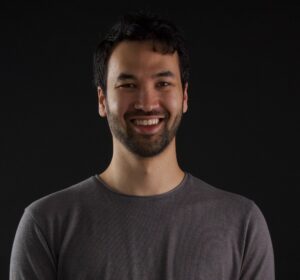
BTL: I have to assume there are other cameras there, as well. How do you work with the other camera team and make sure you don’t end up in their shot or vice versa? Or will those just be removed using CG later?
Temkin: For the most part, we didn’t have to worry too much about getting in the shot, because there were so many angles, we were always gonna be in at least one of the camera’s frames. For the most part, it did kind of go on “just worry about getting the best shot that you can,” and they’ll deal with getting the drone out of [their shot] later.
DiLillo: The legendary Rob Legato was running VFX on this project, so he was painting and cleaning and doing all sorts of behind-the-scenes work that you’ll see in the film.
BTL: What kind of permit do you have to get to shoot with drones? I’m in New York City, and you can’t just have drones just flying around, so when you get permits for the film shoot, do the four blocks include all the air above them?
DiLillo: The pilots themselves need a Part 107, so an FAA license to operate. We need an enormous insurance coverage policy to issue to the city, and then we go through Film LA’s permitting process, register our aircraft with them, communicate our plan of action, and assuming that they approve it, then we can operate. New York has very strict city laws that just ban it, which I think is unfortunate because it could be an incredibly unique way to capture the city that they’re just blocking. So hopefully, soon, they can make adjustments or figure out ways that they can safely and legally do that.
BTL: New York does love its helicopters, though. Did you guys work directly with the stunt teams or are you far enough away that it’s not an issue?
Temkin: We very much work with the stunt team. That’s something that’s very important. Safety, number one. So if there’s a stunt involved that we’re flying with the stunt people, generally having conversations with the stunt coordinators as well as the stuntmen and women involved in that specific scene, just so everyone’s on the same page of what they’re doing. We know what they’re doing. They know what we’re doing, where we can all just do the stunts safely.
BTL: Did you have drones filming during that entire, what I like to call the “Heat shootout”? Were there specific parts that he wanted you guys shooting and others where it wasn’t as necessary to shoot with the drones?
DiLillo: At first, it was only stunt days, and then Michael kind of figured out FPV drones and wanted to use [them] all the time. So excluding dialogue or in the studio days, we were on set, and he gave us an opportunity to either get local surroundings or to be part of the action. Anytime there’s a stunt, we were 100 percent up in the air and operating.
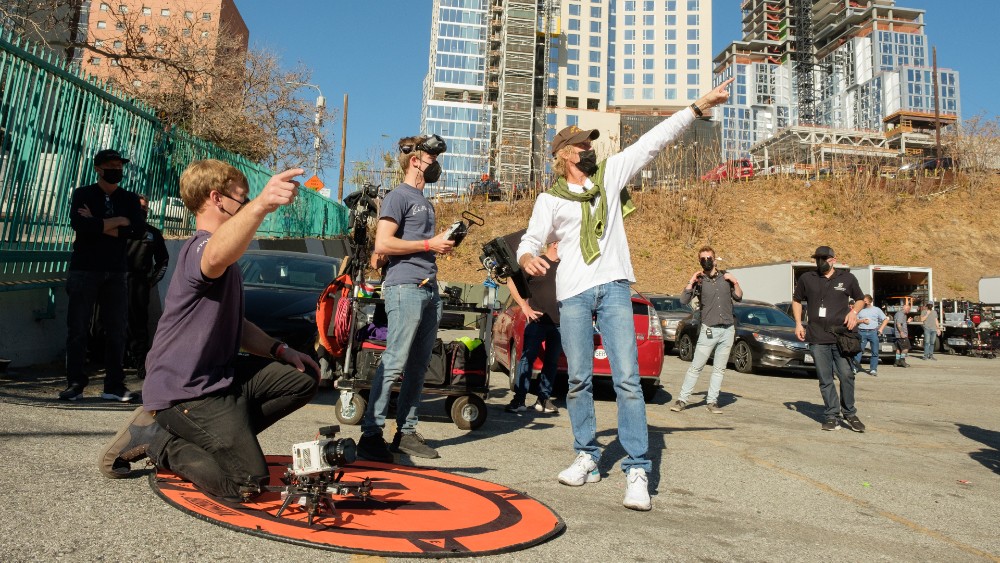
BTL: I definitely noticed the use of drones in the scene of the guy helping them out on the rooftop, and the drone camera is flying around and up to him.
Vanover: Those shots were really cool because those are the first FPV shots I’ve done that didn’t look like FPV shots. Normally, you can tell an FPV drone shot, because it’s almost like a roller coaster, but that was a shot where the drone was more like a tool versus making an FPV shot. For that shot, I remember I had to dive the drone and get a lot of momentum and then basically roll it flat and let that momentum carry me. With these FPV drones that we were using at the time, the camera is fixed to the drone, so if the drone is flying sideways to get that motion, then the camera is going to be sideways as well. You kind of have to cheat it to make it look level. When you mentioned that shot, I remember that being actually a very tricky one, because, again, it was all about timing and precision. Now, we actually have gimbals on FPV drones, so we could do those kinds of shots a lot easier, and also a lot more creative shots. That was a very challenging one at the time.
BTL: Davis, did you say it was all Red cameras that you were using, or were you using different cameras to film?
DiLillo: No, it was all Red. The Komodo is an incredible camera for FPV, because it’s so small, and it’s an RF mount. We can put very small lenses on it, and the camera records up until the last second. So God forbid something happens, you can pull the card out, and it’s good. There’s no buffer. So for these types of stunt action sequences, where we’re putting the camera [at] harm’s risk, it was the perfect camera to use.
BTL: How did you guys work with Roberto, the main DP? Were you constantly checking with him or vice versa on what you were doing?
DiLillo: So he’d check in with us, less so on the stunt sequences, but more when we were just gathering content. He would always give us some type of reference for textures that he wanted to see and just general establishing shots, and would suggest angles. It was definitely collaborative between him and Michael, and they took turns driving us when each other had more available time.
BTL: I was looking at the Lightcraft site and all the different services you offer. Were the drones you were using the ones that could fly up to 120 miles per hour, and was there a time when you were pushing them to that degree?
DiLillo: The drones have changed a lot now. We have much more powerful drones than we used to, but we were probably right up there 80-90 miles an hour with these aircraft. They’re very fast, but yes, it is that same style. We’re not allowed to go over 99 miles an hour because of the FAA. In specific circumstances, you can get a permit to be able to operate above those speeds, but we didn’t need to on this film. It was all well within the speed limit.
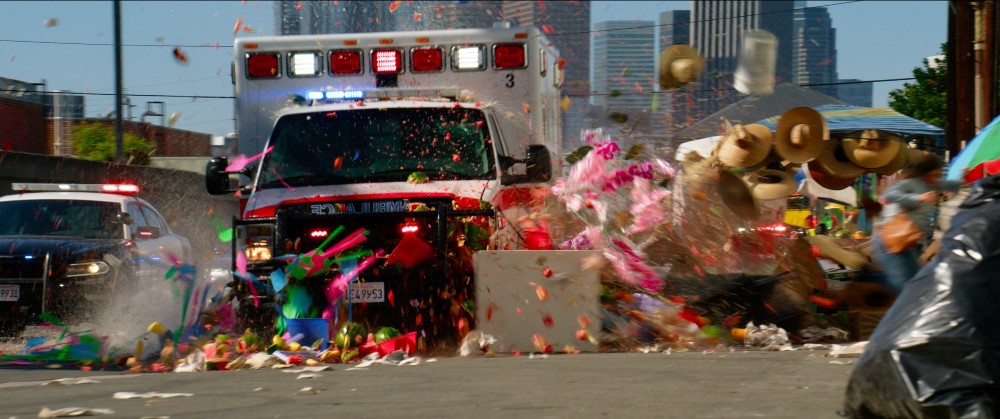
BTL: Do you get involved with the edit at all or do you just turn over the footage to the editor to do their thing, but might they have a question about what or how something was done?
DiLillo: Actually, on this one, Michael gave his notes to the editor. They were using our shots in real time while we were shooting and giving feedback. Some of that feedback that you heard from Michael was from the editor. Though we were not directly communicating with him, he was 100 percent an active part of the shot choices and using the drone like they did in this film.
BTL: Was there any kind of learning curve on your end to integrate with how Michael Bay usually works? He’s been shooting action for ages, but the drones might be something new for him, as well.
Vanover: I think Michael said he’d worked with drones before but never an FPV drone like this. Obviously, he was having to learn what we were capable of, and then once he learned what we were capable of, he tried to push the limit with us throughout the entire movie. But yeah, it’s definitely a learning curve. Michael was really good, though, because, unlike some other directors that we’ve worked with before, he quickly understood that the camera was fixed to the drone, meaning whatever angle the drone’s at, the camera’s gonna see the same thing. He took that as an advantage and was able to come up with some really creative shots that the drone could do, that I think some other people wouldn’t think of doing. That’s just because, like you said, he’s got those action shots just sitting in his mind. And now, he’s got this amazing tool that can create some of the shots that maybe he wouldn’t be able to do without visual effects before.
BTL: One of the scenes at the Staples Center that was particularly impressive was the chase through the parking garage. Did you have drones flying in that sequence as well?
Vanover: That was a very fun day. It was with all these pillars and whatnot, and there was really never any guidance. There were a few times on that day. When I think back to all the shots I did on the movie, I think some of the closest calls I’ve ever had were in that building. Because like, for me, that’s like a racing environment, and that’s my background: drone racing. When we got to that location, I was super excited, because with the drones’ high-speed energy and the pillars wiping by it at 60-70 miles an hour, it brought this energy into the movie that I don’t think you could have gotten with an arm car, because an arm car couldn’t get in there, couldn’t slalom through the pillars or anything like that. There were definitely a lot of times where we had some close calls with the drone. Also, just me scaring Davis very well by just trying to push the limits. But thankfully, we didn’t have any crashes in there, and I’m proud to look back at that.
DiLillo: I’m amazed that we didn’t crash in there. I was clenching the entire time. It was horrifying.
BTL: I was watching that and wondering how on earth they had shot it. I’ve only been to L.A. a few times myself, but what were some of the locations you were excited to have access to that you might not if not for Michael Bay and his pull?
Temkin: It’s really these downtown locations that you need to have full lock-offs to be able to operate a drone. A lot of these places are just city streets. You can’t just go there on any given day and fly a drone. It has to be fully locked-off and permitted. Because Michael Bay was able to do that, it allowed us to fly these drones and do stunts in places that we would have never thought to do so.
BTL: Have you shot anything since doing Ambulance that you’re excited for people to see?
Temkin: There’s all sorts of stuff. Davis, I don’t know what we’re allowed to talk about. That’s always the fun part. It’s like, yeah, we worked on a bunch of stuff. I don’t know what we can say we’ve worked on. There are a lot of projects that we’ve been working on that are coming out and a lot of drone technologies that we’ve been developing for these projects that will just keep pushing the limits of what’s possible with these drones. So that’s what I’d say to look out for is really just to see the evolution of drones in the film world.
Ambulance is now streaming on Peacock and VOD. Watch Lightcraft’s reel below and learn more about their services at Lightcraft.tv.





